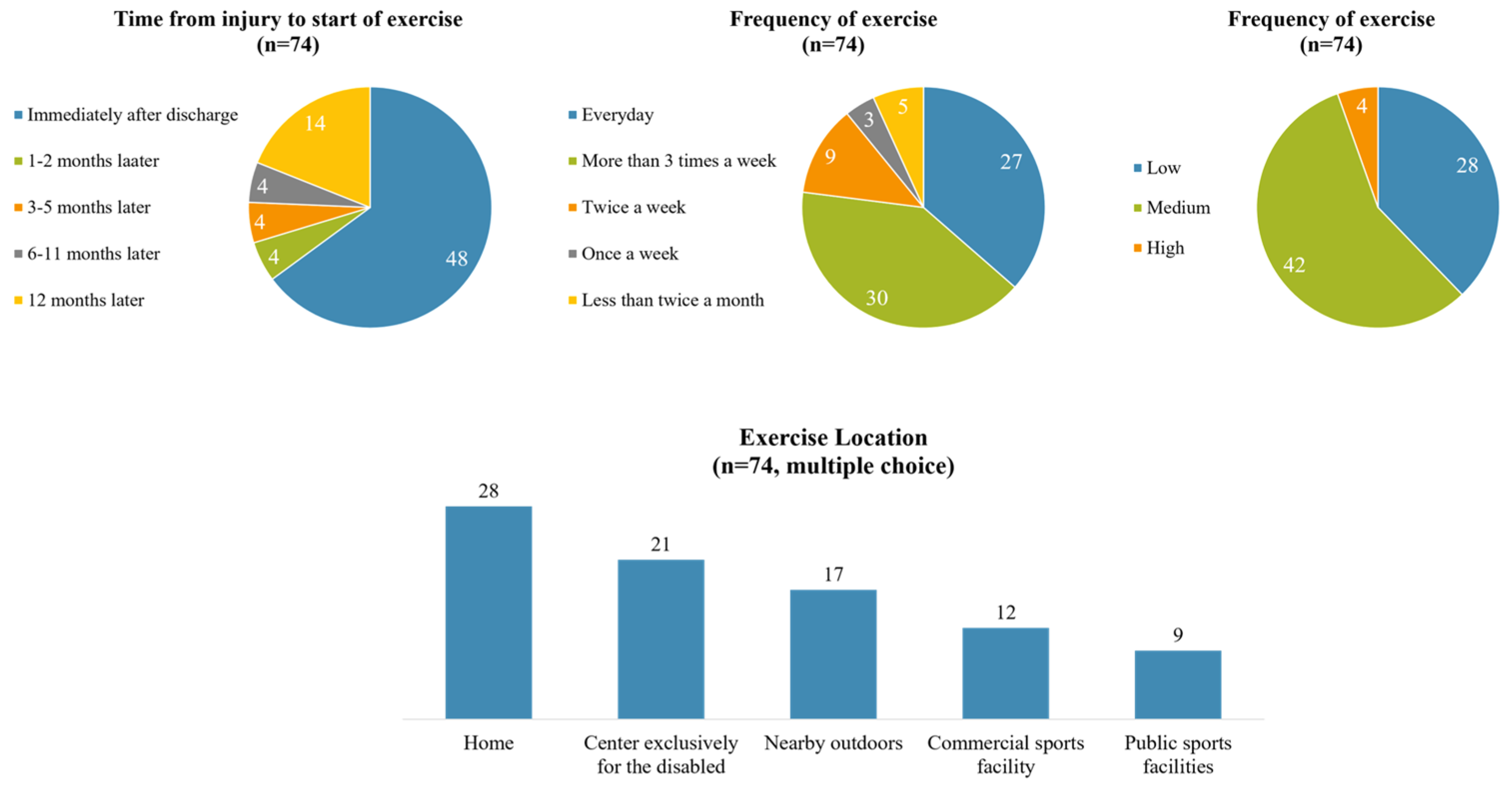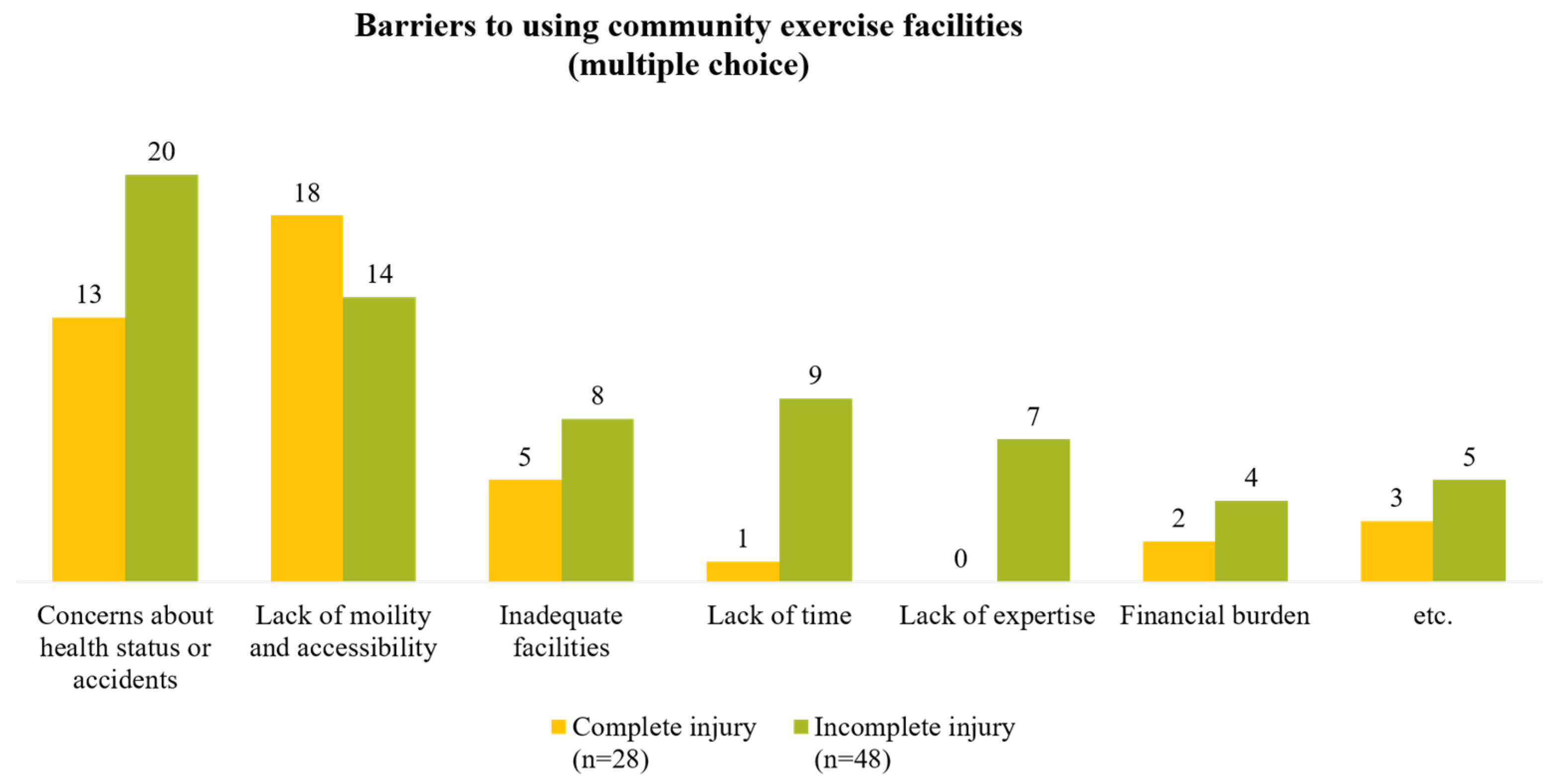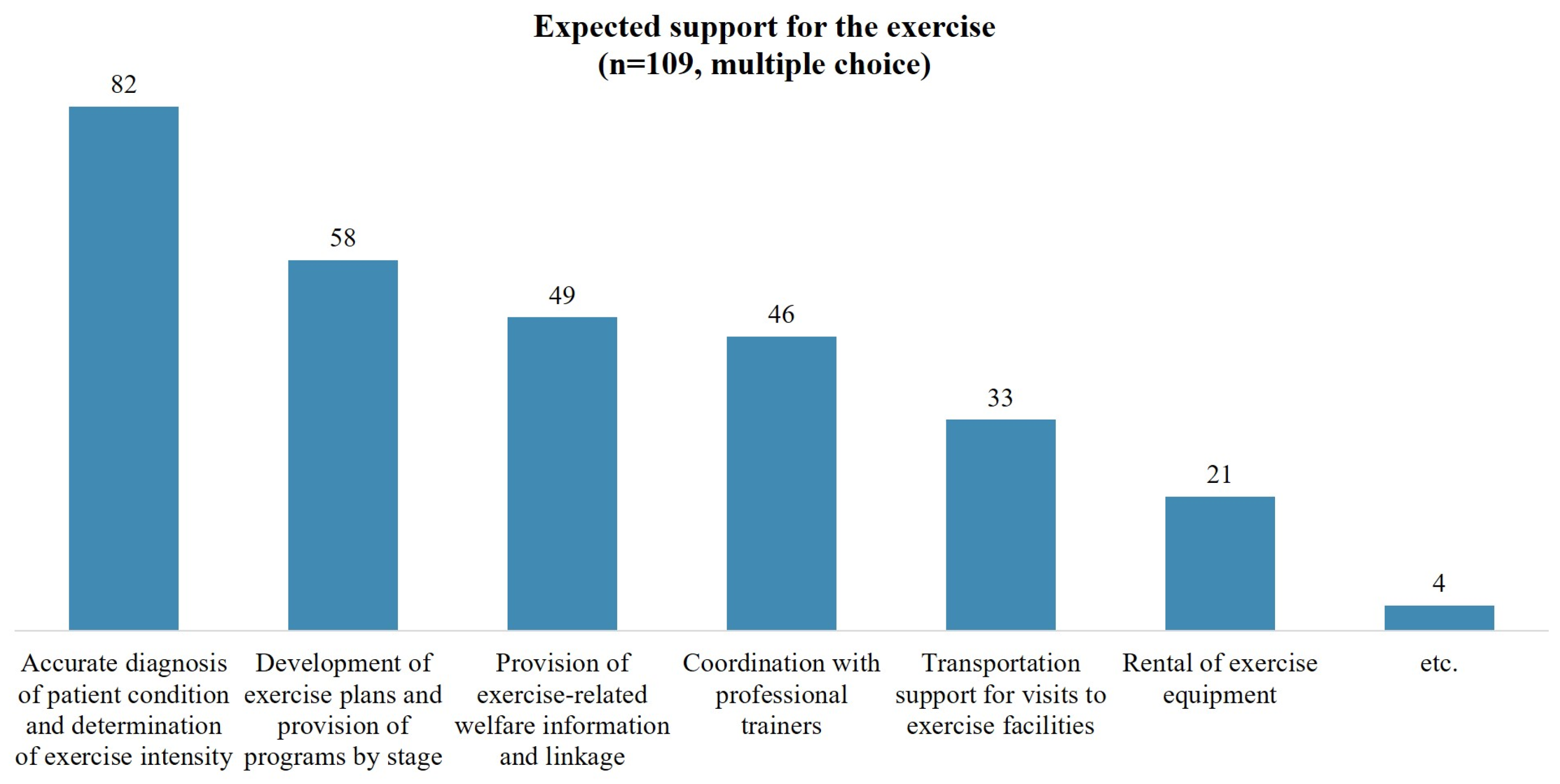Current Status and Barriers of Exercise in Individuals with Spinal Cord Injuries in Korea: A Survey
Abstract
1. Introduction
2. Materials and Methods
2.1. Survey Design
2.2. Study Sample
2.3. Statistical Analyses
3. Results
3.1. Respondents’ Characteristics
3.2. Differences in Characteristics Depending on Exercise Performance
3.3. Comparison of Individuals’ Status and Quality of Life according to Exercise Participation
3.4. Status of Community Exercise Facility Usage in Relation to Subjective Health and Injury Severity
3.5. Exercise Frequency, Intensity, Time, and Place in Exercise Group
3.6. Barriers to Exercise and Facility Usage
4. Discussion
5. Conclusions
Supplementary Materials
Author Contributions
Funding
Institutional Review Board Statement
Informed Consent Statement
Data Availability Statement
Conflicts of Interest
References
- World Health Organization. International Perspectives on Spinal Cord Injury. Available online: https://www.who.int/publications/i/item/international-perspectives-on-spinal-cord-injury (accessed on 10 March 2024).
- Choi, Y.; Leigh, J.H.; Jeon, J.; Lee, G.J.; Shin, H.I.; Bang, M.S. Trends in the Incidence and Etiology of Non-Traumatic Spinal Cord Injury in Korea: A Nationwide Population-Based Study from 2007 to 2020. J. Korean Med. Sci. 2023, 38, e158. [Google Scholar] [CrossRef]
- McCammon, J.R.; Ethans, K. Spinal cord injury in Manitoba: A provincial epidemiological study. J. Spinal Cord Med. 2011, 34, 6–10. [Google Scholar] [CrossRef]
- National Spinal Cord Injury Statistical Center. The 2023 Annual Statistical Report Complete Public Version for the Spinal Cord Injury Model Systems. Birmingham, Alabama: National Spinal Cord Injury Statistical Center. 2023. Available online: https://www.nscisc.uab.edu/public_pages/reportsstats (accessed on 16 April 2024).
- Algahtany, M.; McFaull, S.; Chen, L.; Zhang, S.; Saarela, O.; Alqahtani, F.; Cusimano, M.D. The Changing Etiology and Epidemiology of Traumatic Spinal Injury: A Population-Based Study. World Neurosurg. 2021, 149, e116–e127. [Google Scholar] [CrossRef]
- Moschovou, M.; Antepohl, W.; Halvorsen, A.; Pettersen, A.L.; Divanoglou, A. Temporal changes in demographic and injury characteristics of traumatic spinal cord injuries in Nordic countries—A systematic review with meta-analysis. Spinal Cord 2022, 60, 765–773. [Google Scholar] [CrossRef]
- Ding, W.; Hu, S.; Wang, P.; Kang, H.; Peng, R.; Dong, Y.; Li, F. Spinal Cord Injury: The Global Incidence, Prevalence, and Disability from the Global Burden of Disease Study 2019. Spine 2022, 47, 1532–1540. [Google Scholar] [CrossRef]
- Groah, S.L.; Charlifue, S.; Tate, D.; Jensen, M.P.; Molton, I.R.; Forchheimer, M.; Krause, J.S.; Lammertse, D.P.; Campbell, M. Spinal cord injury and aging: Challenges and recommendations for future research. Am. J. Phys. Med. Rehabil. 2012, 91, 80–93. [Google Scholar] [CrossRef]
- Groah, S.L.; Nash, M.S.; Ward, E.A.; Libin, A.; Mendez, A.J.; Burns, P.; Elrod, M.; Hamm, L.F. Cardiometabolic risk in community-dwelling persons with chronic spinal cord injury. J. Cardiopulm. Rehabil. Prev. 2011, 31, 73–80. [Google Scholar] [CrossRef]
- Maher, J.L.; McMillan, D.W.; Nash, M.S. Exercise and Health-Related Risks of Physical Deconditioning After Spinal Cord Injury. Topics Spinal Cord Inj. Rehabil. 2017, 23, 175–187. [Google Scholar] [CrossRef]
- Neefkes-Zonneveld, C.R.; Bakkum, A.J.; Bishop, N.C.; van Tulder, M.W.; Janssen, T.W. Effect of long-term physical activity and acute exercise on markers of systemic inflammation in persons with chronic spinal cord injury: A systematic review. Arch. Phys. Med. Rehabil. 2015, 96, 30–42. [Google Scholar] [CrossRef]
- Kocina, P. Body composition of spinal cord injured adults. Sports Med. 1997, 23, 48–60. [Google Scholar] [CrossRef]
- Ditor, D.S.; Latimer, A.E.; Ginis, K.A.; Arbour, K.P.; McCartney, N.; Hicks, A.L. Maintenance of exercise participation in individuals with spinal cord injury: Effects on quality of life, stress and pain. Spinal Cord 2003, 41, 446–450. [Google Scholar] [CrossRef]
- Anneken, V.; Hanssen-Doose, A.; Hirschfeld, S.; Scheuer, T.; Thietje, R. Influence of physical exercise on quality of life in individuals with spinal cord injury. Spinal Cord 2010, 48, 393–399. [Google Scholar] [CrossRef]
- Miller, L.E.; Herbert, W.G. Health and economic benefits of physical activity for patients with spinal cord injury. ClinicoEcon Outcomes Res 2016, 8, 551–558. [Google Scholar] [CrossRef]
- Koo, K.M.; Kim, C.J. Association Between Level of Physical Activity and Self-rated Health in People with Spinal Cord Injury. J. Spec. Educ. Rehabil. Sci. 2016, 55, 155–168. [Google Scholar] [CrossRef]
- Rocchi, M.; Routhier, F.; Latimer-Cheung, A.E.; Ginis, K.A.M.; Noreau, L.; Sweet, S.N. Are adults with spinal cord injury meeting the spinal cord injury-specific physical activity guidelines? A look at a sample from a Canadian province. Spinal Cord 2017, 55, 454–459. [Google Scholar] [CrossRef]
- Rauch, A.; Hinrichs, T.; Oberhauser, C.; Cieza, A.; SwiSCI study group. Do people with spinal cord injury meet the WHO recommendations on physical activity? Int. J. Public Health 2016, 61, 17–27. [Google Scholar] [CrossRef]
- Hoevenaars, D.; Holla, J.F.M.; Postma, K.; van der Woude, L.H.V.; Janssen, T.W.J.; de Groot, S. Associations between meeting exercise guidelines, physical fitness, and health in people with spinal cord injury. Disabil. Rehabil. 2023, 45, 1030–1037. [Google Scholar] [CrossRef]
- Soriano, J.E.; Squair, J.W.; Cragg, J.J.; Thompson, J.; Sanguinetti, R.; Vaseghi, B.; Emery, C.A.; Grant, C.; Charbonneau, R.; Larkin-Kaiser, K.A.; et al. A national survey of physical activity after spinal cord injury. Sci. Rep. 2022, 12, 4405. [Google Scholar] [CrossRef]
- Cowan, R.E.; Nash, M.S.; Anderson, K.D. Exercise participation barrier prevalence and association with exercise participation status in individuals with spinal cord injury. Spinal Cord 2013, 51, 27–32. [Google Scholar] [CrossRef] [PubMed]
- Gorgey, A.S. Exercise awareness and barriers after spinal cord injury. World J. Orthop. 2014, 5, 158–162. [Google Scholar] [CrossRef] [PubMed]
- Kim, C.J.; Song, H.J. Factors Associated with Participating Physical Activity Among Disabled Populations with Spinal Cord Injury. J. Spec. Educ. Rehabil. Sci. 2014, 53, 69–86. [Google Scholar] [CrossRef]
- Yoon, H.S.; Park, H.; Lee, C.W.; Choi, S.H. The analysis of inactive people with spinal cord injury. Legis. Policy Stud. 2017, 9, 395–419. [Google Scholar]
- National Rehabilitation Center. Development of Exercise Programs according to the Disability Levels of Individuals with Spinal Cord Injury. Available online: https://scienceon.kisti.re.kr/commons/util/originalView.do?cn=TRKO201800037676&dbt=TRKO&rn= (accessed on 12 January 2024).
- Kehn, M.; Kroll, T. Staying physically active after spinal cord injury: A qualitative exploration of barriers and facilitators to exercise participation. BMC Public Health 2009, 9, 168. [Google Scholar] [CrossRef] [PubMed]
- Rimmer, J.H.; Riley, B.; Wang, E.; Rauworth, A. Accessibility of health clubs for people with mobility disabilities and visual impairments. Am. J. Public Health 2005, 95, 2022–2028. [Google Scholar] [CrossRef]
- Pelletier, C. Exercise prescription for persons with spinal cord injury: A review of physiological considerations and evi-dence-based guidelines. Appl. Physiol. Nutr. Metab. 2023, 48, 882–895. [Google Scholar] [CrossRef] [PubMed]
- Martin Ginis, K.A.; van der Scheer, J.W.; Latimer-Cheung, A.E.; Barrow, A.; Bourne, C.; Carruthers, P.; Bernardi, M.; Ditor, D.S.; Gaudet, S.; de Groot, S.; et al. Evidence-based scientific exercise guidelines for adults with spinal cord injury: An update and a new guideline. Spinal Cord 2018, 56, 308–321. [Google Scholar] [CrossRef]
- Shin, H. Etiology and epidemiology of spinal cord injury in Korea. J. Korean Med. Assoc. 2020, 63, 589–595. [Google Scholar] [CrossRef]
- International Spinal Cord Injury Community Survey. Available online: https://insci.network/insci/T1/en/download.php (accessed on 15 March 2024).
- Household Balance per Household by Income Quintile (National, Two or More Persons). Available online: https://kosis.kr/statHtml/statHtml.do?orgId=101&tblId=DT_1L9V003&conn_path=I2 (accessed on 20 March 2024).
- Stevens, S.L.; Caputo, J.L.; Fuller, D.K.; Morgan, D.W. Physical activity and quality of life in adults with spinal cord injury. J. Spinal Cord Med. 2008, 31, 373–378. [Google Scholar] [CrossRef]
- Bull, F.C.; Al-Ansari, S.S.; Biddle, S.; Borodulin, K.; Buman, M.P.; Cardon, G.; Carty, C.; Chaput, J.P.; Chastin, S.; Chou, R.; et al. World Health Organization 2020 guidelines on physical activity and sedentary behaviour. Br. J. Sports Med. 2020, 54, 1451–1462. [Google Scholar] [CrossRef]
Disclaimer/Publisher’s Note: The statements, opinions, and data contained in all publications are solely those of the individual author(s) and contributor(s) and not of MDPI and/or the editor(s). MDPI and/or the editor(s) disclaim responsibility for any injury to people or property resulting from any ideas, methods, instructions, or products referred to in the content. |




| Variables | Categories | Exercise Group n (%) | Non-Exercise Group n (%) | p-Value |
|---|---|---|---|---|
| Gender | Male | 49 (66.22) | 28 (80.00) | 0.140 |
| Female | 25 (33.78) | 7 (20.00) | ||
| Age (years) | 19~28 | 4 (5.41) | 0 (0.0) | 0.134 |
| 29~38 | 0 (0.0) | 1 (2.86) | ||
| 39~48 | 11 (14.86) | 6 (17.14) | ||
| 49~58 | 19 (25.68) | 15 (42.86) | ||
| 59~68 | 27 (36.49) | 7 (20.00) | ||
| Over 69 | 13 (17.57) | 6 (17.14) | ||
| Marital status | Single | 13 (17.57) | 9 (25.71) | 0.375 |
| Married | 52 (70.27) | 21 (60.00) | ||
| Cohabiting | 1 (1.35) | 0 (0.0) | ||
| Divorced or separated | 5 (6.76) | 5 (14.29) | ||
| Widowed | 3 (4.05) | 0 (0.0) | ||
| Household composition | Live alone | 14 (18.92) | 10 (28.57) | 0.375 |
| Live with more than two people | 60 (81.08) | 25 (71.43) | ||
| Income level (Million Korean Won) | Under 2 | 29 (39.19) | 21 (60.00) | 0.216 |
| 2~3.99 | 24 (32.43) | 5 (14.29) | ||
| 4~5.99 | 10 (13.51) | 4 (11.43) | ||
| 5~7.99 | 8 (10.81) | 5 (14.29) | ||
| 8~9.99 | 2 (2.70) | 0 (0.0) | ||
| Over 10 | 1 (1.35) | 0 (0.0) | ||
| Time since injruy (years) | Under 0.5 | 1 (1.35) | 0 (0.0) | 0.346 |
| 0.5~1 | 4 (5.41) | 2 (5.71) | ||
| 1~5 | 26 (35.14) | 6 (17.14) | ||
| 5~10 | 15 (20.27) | 10 (28.57) | ||
| Over 10 | 28 (37.84 | 17 (48.57) | ||
| Type of injury | Traumatic | 39 (52.70) | 26 (74.29) | 0.032 * |
| Non-traumatic | 35 (47.30) | 9 (25.71) | ||
| Level of injury | Cervical | 38 (51.35) | 20 (57.14) | 0.831 |
| Thoracic | 28 (37.84) | 12 (34.29) | ||
| Lumbar | 8 (10.81) | 3 (8.57) | ||
| Sacral | 0 (0.0) | 0 (0.0) | ||
| ASIA 1 Impairment Scale | A | 18 (24.32) | 15 (42.86) | 0.018 * |
| B | 6 (8.11) | 6 (17.14) | ||
| C | 11 (14.86) | 6 (17.14) | ||
| D | 39 (52.70) | 8 (22.86) | ||
| Smoking | Yes | 12 (16.22) | 7 (20.0) | 0.627 |
| No | 62 (83.78) | 28 (80.0) | ||
| Drinking | Yes | 14 (18.92) | 6 (17.14) | 0.823 |
| No | 60 (81.08) | 29 (82.86) | ||
| Voiding difficulty | Yes | 41 (55.41) | 28 (80.0) | 0.013 * |
| No | 33 (44.59) | 7 (20.0) | ||
| Defecation difficulty | Yes | 44 (59.46) | 27 (77.14) | 0.070 |
| No | 30 (40.54) | 8 (22.86) |
| Exercise Group (n = 74) | Non-Exercise Group (n = 35) | p-Value | ||
|---|---|---|---|---|
| Impact of complication on daily life | No problem at all | 6 (8.11) | 1 (2.86) | 0.012 * |
| Slightly problematic | 9 (12.16) | 1 (2.86) | ||
| Average | 9 (12.16) | 2 (5.71) | ||
| Slightly problematic | 26 (35.14) | 7 (20.00) | ||
| Severely problematic | 24 (32.43) | 24 (68.57) | ||
| Subjective health perception | Very good | 0 (0.0) | 0 (0.0) | 0.329 |
| Good | 4 (5.4) | 3 (8.6) | ||
| Fair | 38 (51.4) | 12 (34.3) | ||
| Poor | 25 (33.8) | 14 (40.0) | ||
| Very poor | 7 (9.5) | 6 (17.1) | ||
| Pain score | 4.82 ± 2.74 | 6.11 ± 2.27 | 0.017 * | |
| Score for activity | Activities of Daily Living | 3.18 ± 1.11 | 2.57 ± 1.12 | 0.009 * |
| Mobility | 3.15 ± 1.19 | 2.55 ± 1.10 | 0.013 * | |
| Function and participation | 3.20 ± 1.08 | 2.78 ± 0.98 | 0.055 |
| Experience with Community Exercise Facilities | Subjective Health Perception | ASIA 1 Impairment Scale | ||||||||
|---|---|---|---|---|---|---|---|---|---|---|
| Good | Fair | Poor | Very Poor | p-Value | A | B | C | D | p-Value | |
| Yes n, (%) | 2 (28.57) | 22 (44.00) | 2 (17.95) | 2 (15.38) | 0.033 * | 5 (15.15) | 2 (16.67) | 4 (23.53) | 22 (46.71) | 0.013 * |
| No n, (%) | 5 (71.43) | 28 (56.00) | 32 (82.05) | 11 (84.62) | 28 (84.85) | 10 (83.33) | 13 (76.47) | 25 (53.19) | ||
Disclaimer/Publisher’s Note: The statements, opinions and data contained in all publications are solely those of the individual author(s) and contributor(s) and not of MDPI and/or the editor(s). MDPI and/or the editor(s) disclaim responsibility for any injury to people or property resulting from any ideas, methods, instructions or products referred to in the content. |
© 2024 by the authors. Licensee MDPI, Basel, Switzerland. This article is an open access article distributed under the terms and conditions of the Creative Commons Attribution (CC BY) license (https://creativecommons.org/licenses/by/4.0/).
Share and Cite
Kim, Y.; Ko, S.-H.; Lee, J.-L.; Huh, S. Current Status and Barriers of Exercise in Individuals with Spinal Cord Injuries in Korea: A Survey. Healthcare 2024, 12, 1030. https://doi.org/10.3390/healthcare12101030
Kim Y, Ko S-H, Lee J-L, Huh S. Current Status and Barriers of Exercise in Individuals with Spinal Cord Injuries in Korea: A Survey. Healthcare. 2024; 12(10):1030. https://doi.org/10.3390/healthcare12101030
Chicago/Turabian StyleKim, Yuna, Sung-Hwa Ko, Jung-Lim Lee, and Sungchul Huh. 2024. "Current Status and Barriers of Exercise in Individuals with Spinal Cord Injuries in Korea: A Survey" Healthcare 12, no. 10: 1030. https://doi.org/10.3390/healthcare12101030
APA StyleKim, Y., Ko, S.-H., Lee, J.-L., & Huh, S. (2024). Current Status and Barriers of Exercise in Individuals with Spinal Cord Injuries in Korea: A Survey. Healthcare, 12(10), 1030. https://doi.org/10.3390/healthcare12101030













